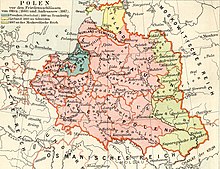Kiev Voivodeship
| |||||||||||
|---|---|---|---|---|---|---|---|---|---|---|---|
| Voivodeship of Polish–Lithuanian Commonwealth¹ | |||||||||||
| 1471–1793 | |||||||||||
 The Kiev Voivodeship in the Polish–Lithuanian Commonwealth in 1635. | |||||||||||
| Capital | (Kijów (Kyiv), 1471–1667), Żytomierz (Zhytomyr, 1667–1793) | ||||||||||
| Demonym | Kievan | ||||||||||
| Area | |||||||||||
• 1793 | 200,000 km2 (77,000 sq mi) | ||||||||||
| Population | |||||||||||
• 1793 | 500,000 | ||||||||||
| Government | |||||||||||
| Voivode | |||||||||||
• 1471–1475 | Martynas Goštautas (first) | ||||||||||
• 1559–1608 | Konstanty Wasyl Ostrogski (transition) | ||||||||||
• 1791–1793 | Antoni Protazy Potocki (last) | ||||||||||
| History | |||||||||||
• death of Simeon Olelkovich | 1471 | ||||||||||
• 2nd Muscovite–Lithuanian War | 1503 | ||||||||||
| 1569 | |||||||||||
| 1648 | |||||||||||
| 1667 | |||||||||||
| 1793 | |||||||||||
| Political subdivisions | counties:
| ||||||||||
| |||||||||||
| ¹ Voivodeship of the Kingdom of Poland. The kingdom was part of the Polish–Lithuanian Commonwealth from 1569. | |||||||||||




The Kiev Voivodeship[1] (Polish: województwo kijowskie; Latin: Palatinatus Kioviensis; Ukrainian: Київське воєводство, romanized: Kyivske voievodstvo) was a unit of administrative division and local government in the Grand Duchy of Lithuania from 1471 until 1569 and of the Crown of the Kingdom of Poland from 1569 until 1793, as part of Lesser Poland Province of the Polish Crown. On some maps Kiev Voivodeship was also named as the Lower Volhynia.
The voivodeship was established in 1471 upon the death of the last prince of Kiev Simeon Olelkovich and transformation of the Duchy of Kiev (appanage duchy of the Grand Duchy of Lithuania) into the Voivodeship of Kiev.




